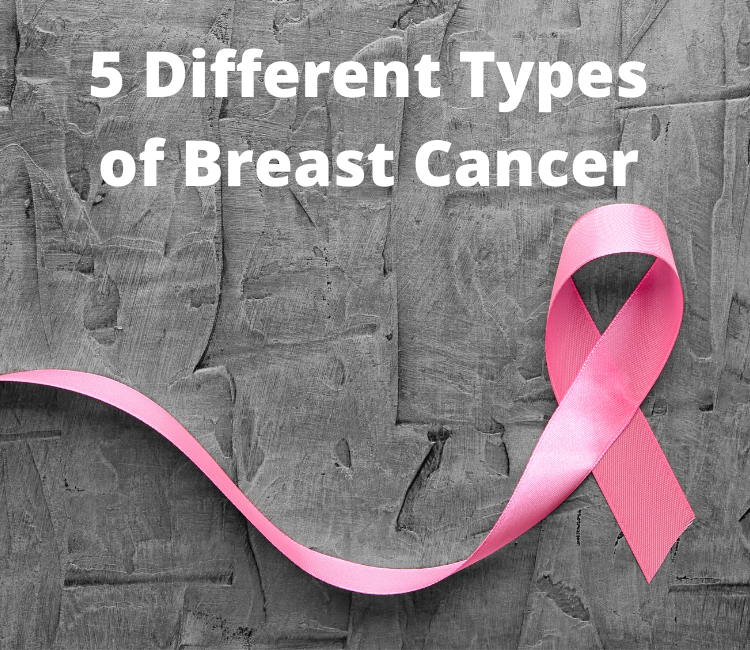5 Different Types of Breast Cancer
Did you know that breast cancer is the second most diagnosed cancer in women next to skin cancer? According to the American Cancer Society (ACS), in 2021, there will be about 284,200 cases of breast cancer diagnosed.
Breasts have three main parts called ducts, lobules, and connective tissue. The ducts are tubes that carry milk from the lobules glands, which produce milk. The connective tissue connects and holds everything all together.
Different types of breast cancer can develop in areas of the breast, such as the ducts or lobules. In some cases, women have no physical symptoms, which is why it’s important to maintain annual breast screenings for early detection.
What are the different types of breast cancer?
There are two categories for breast cancer, invasive and non-invasive. Here are five common invasive and non-invasive types of breast cancers and the possible treatments.
1. Ductal Carcinoma In Situ (DCIS)
Ductal carcinoma in situ (DCIS) develops in the milk ducts and is the most common type of breast cancer. According to Cancer Treatment Centers of America, about one in every five new breast cancer cases is DCIS. This stage of breast cancer is considered non-invasive because the cancerous cells have not spread from the milk ducts to the surrounding breast tissue.
The recommended treatment and therapy for DCIS are a lumpectomy and radiation. The risk of recurrence is about 15 percent. With treatment and therapy, DCIS is not life-threatening. There is nearly a 100 percent survival rate for women.
2. Invasive Ductal Carcinoma (IDC)
Invasive ductal carcinoma (IDC) is when the cancer cells develop in the milk ducts and spread to the surrounding breast tissue and possibly the lymph nodes. According to the American Cancer Society, in the United States, more than 180,000 women are diagnosed with IDC each year.
The recommended treatment typically is surgery with a lumpectomy or a possible mastectomy (removal of the breast). The type of surgery depends on different factors, such as the size and stage of cancer. Chemotherapy and radiation therapy may be recommended. Your physician will advise you on the type of treatment and therapy best for you.
3. Triple-Negative Breast Cancer (TNBC)
Triple-negative breast cancer (TNBC) refers to cancer cells testing negatively on estrogen or progesterone receptors and don’t make much HER2 protein. TNBC is more common in African American women younger than 40 or who have a BRCA1 gene.
TNBC is invasive and tends to spread faster than most breast cancers because of no hormone receptors (estrogen and progesterone). Hormone therapy cannot be used to help treat this type of breast cancer. Treatments that target HER2 are also not helpful because of the lack of the HER2 protein. TNBC treatments are limited, but chemotherapy may be used as a possible treatment.
4. Inflammatory Breast Cancer (IBC)
Inflammatory breast cancer (IBC) is invasive and aggressively grows by cancer cells blocking the skin and lymph vessels of the breast, causing inflammation in the skin. According to the American Cancer Society, IBC accounts for 1-5% of all breast cancers. According to the American Cancer Society, in about 1 of 3 cases, IBC has spread to different parts of the body, making it hard to treat successfully. Once IBC is initially diagnosed, it has spread into the skin, meaning it’s stage III cancer.
IBC is hard to detect as it doesn’t always show up on a mammogram screening or display symptoms such as a breast lump until the lymph vessels are blocked by the breast cancer cells. Symptoms of itching, redness, and tenderness are common.
African American women tend to develop IBC more often than white women. It is also more common to develop in women overweight or obese.
IBC treatment usually includes surgery of a total mastectomy and radiation therapy. Hormone therapy, as well as chemotherapy, may also be used.
5. Metastatic Breast Cancer
Metastatic breast cancer is known as advanced breast cancer or stage IV. This form of breast cancer has spread in the body to other organs such as the brain, lung, liver, and bone. Once the cancerous tumor is removed, small tumor cells may remain in the body, causing cancer to return and possibly spread.
Metastatic breast cancer treatment includes surgery to remove the cancerous tumor and therapy such as chemo, hormone, radiation, and targeted therapy. Some treatments or therapy will be combined. Your physician will advise you on the type of treatment and therapy to best suit your needs.
Schedule Your Next Breast Health Screening with Dr. Gore today!
If you have breast concerns, schedule your breast appointment with Dr. Gore by contacting North Atlanta Breast Care.
Disclaimer: This article is not a substitution for seeking medical attention.

